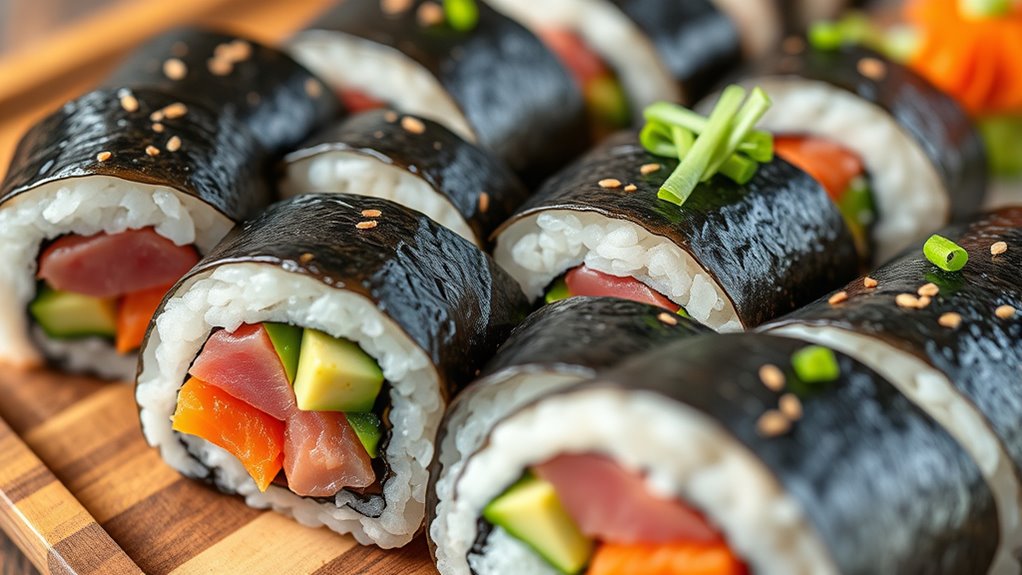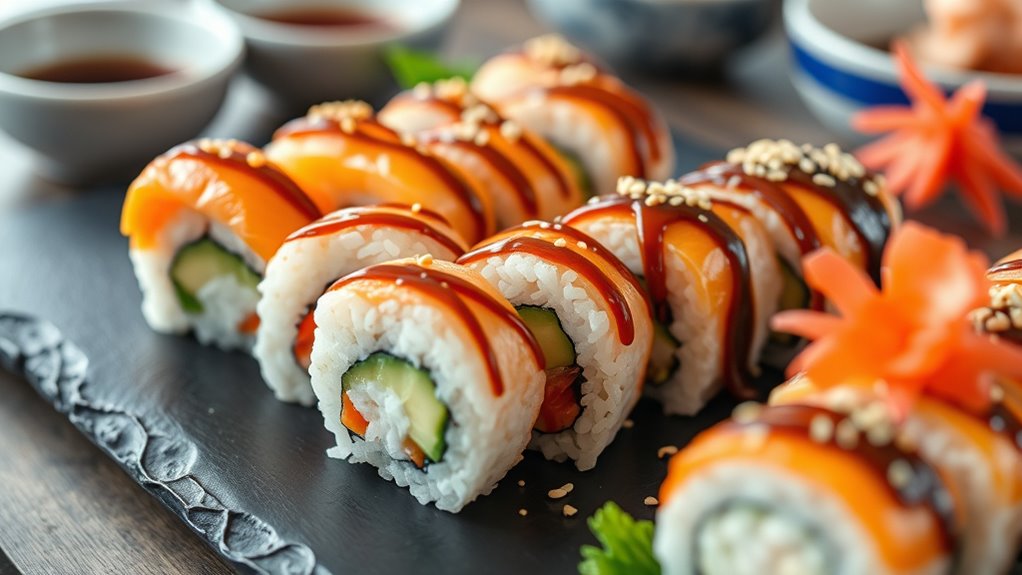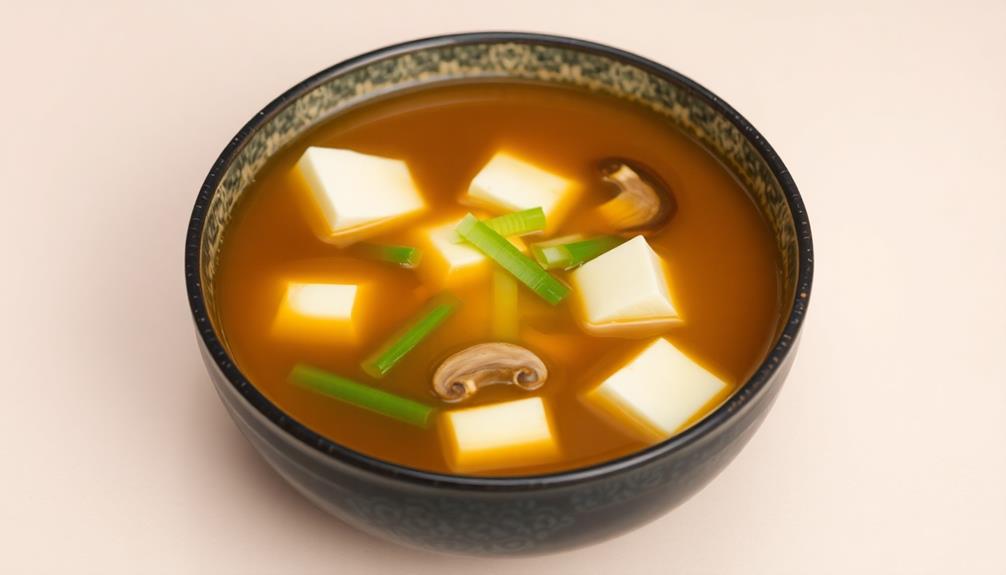To start with sushi rolls, focus on essential ingredients like sushi rice, nori, fresh fish or vegetables, and a bamboo mat for rolling. Handle the rice gently, keep your hands moist, and spread the rice evenly on the nori. Place fillings near the edge, then roll away from you with gentle pressure for a tight finish. Remember, practicing improves technique. Exploring regional styles and tips will help you create more authentic sushi—there’s much more to discover.
Key Takeaways
- Use fresh ingredients like sushi rice, nori, fillings, and a bamboo mat for authentic sushi rolls.
- Handle rice gently and keep hands moistened to prevent sticking and ensure even spreading.
- Place fillings near the edge of the nori before rolling, applying gentle pressure to create a tight roll.
- Practice rolling techniques to improve uniformity, understanding regional styles can enhance your approach.
- Recognize regional variations in sushi styles to deepen appreciation and adapt your methods accordingly.

Have you ever wondered what makes Japanese cuisine so unique and beloved worldwide? One of its standout features is the artistry behind sushi rolls. Learning sushi rolling techniques might seem intimidating at first, but once you get the hang of it, you’ll find it’s both fun and rewarding. Sushi isn’t just about raw fish; it’s about balance, precision, and the way flavors come together. As you start, it’s helpful to understand that regional Japanese dishes influence sushi styles across the country. For example, in Osaka, you’ll find more pressed sushi, while in Tokyo, the focus is on delicate, hand-rolled varieties. Recognizing these regional differences gives you insight into the diversity of sushi and how chefs adapt techniques to local ingredients and tastes.
To begin, gather your ingredients: sushi rice, nori (seaweed), fresh fish or vegetables, and a bamboo mat for rolling. The key to successful sushi rolls lies in mastering your sushi rolling techniques. You want to handle the rice gently to avoid crushing it, and spread it evenly over the nori. Keep a bowl of water nearby to moisten your hands; this prevents the rice from sticking excessively to your fingers. Place your fillings in a line near the edge of the nori, then lift the bamboo mat and roll it away from you, applying gentle pressure to keep the roll tight. Practice makes perfect here—initial attempts may be uneven, but with patience, your rolls will become more uniform. Additionally, understanding the importance of regional variations in sushi styles can help you appreciate the diversity and adapt your techniques accordingly.
Frequently Asked Questions
What Are the Different Types of Sushi Rolls Beyond the Basics?
You can explore a variety of sushi rolls beyond the basics, like fusion rolls that combine different cuisines and regional varieties that highlight local ingredients and flavors. Fusion rolls might include spicy tuna or avocado, blending traditions creatively. Regional varieties, such as Osaka-style or Hokkaido-style rolls, showcase unique ingredients and techniques. Trying these options adds excitement to your sushi experience and helps you appreciate the diverse culinary landscape of Japanese sushi.
How Do I Properly Use Chopsticks When Eating Sushi?
Think of using chopsticks as mastering a dance, where your grip sets the rhythm. To properly handle them, hold one chopstick like a pencil, with the other resting between your thumb and index finger. Keep the top chopstick steady while the bottom moves. Practice with small movements, and soon you’ll glide through sushi with grace, turning each bite into a symphony of skill and enjoyment.
Are There Any Common Sushi Etiquette Rules to Follow?
You should follow basic table manners, like not sticking chopsticks upright in your sushi and avoiding pointing with them. When finished, place your chopsticks neatly on the side. Tipping isn’t customary in Japan, but if you’re in a more Western setting, a small tip shows appreciation. Respect the chef and other diners, keep your voice moderate, and enjoy your sushi experience with good manners.
What Are the Health Benefits of Eating Sushi?
Eating sushi offers great health advantages, such as providing high-quality protein, omega-3 fatty acids, and essential nutrients. The sushi nutrition benefits include supporting heart health, improving brain function, and helping with weight management. You’ll also get vitamins and minerals from the vegetables and seafood. Just remember to choose fresh, properly prepared sushi to maximize these health benefits and enjoy a balanced, nutritious meal.
How Can I Make Sushi Rolls at Home Easily?
To make sushi rolls at home easily, start by gathering simple homemade sushi ingredients like sushi rice, nori, fresh fish, and vegetables. Use basic sushi rolling techniques, laying the nori on a bamboo mat, spreading rice evenly, and adding your fillings. Roll tightly, then cut into slices. Keep your hands moist to prevent sticking, and enjoy your homemade sushi for a fun, delicious experience that’s healthier and tailored to your taste!
Conclusion
So, now that you’ve mastered the art of sushi rolls, you’re practically a culinary ninja—just don’t let the sushi obsession turn you into a raw fish connoisseur overnight. Remember, Japanese cuisine is about balance, patience, and a dash of humility (and maybe soy sauce). Keep experimenting, stay humble, and soon you’ll be rolling with the best. After all, in the sushi world, even beginners can become masters—one clever bite at a time.









